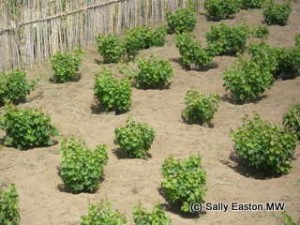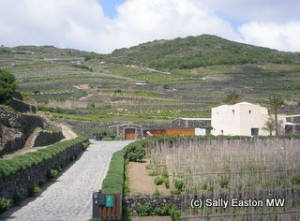Pantelleria rejuvenated

Bush vines planted in hollows
Pantelleria is a small volcanic island, just 14km by 9km in size, off the south west coast of Sicily, and nearer to Tunisia than the rest of Italy.
The island’s main claim to fame is as an historic producer of fine sweet wine. Along with other celebrated sweet wines of the 19th century, passito di Pantelleria has a distinguished heritage, and after a period of decline, one that has been revived in the modern era, almost single-handedly, by Donnafugata.
In the heat of the near-African Mediterranean, grape growing conditions can be extreme. Heat is a given, and the island is also extremely windy, which helps to keep fruit healthy. Furthermore, while the island may have only around 400mm rainfall per annum, morning dews from the 836m Monte Grande in the middle of the island provide sufficient moisture to keep crops alive during the summer heat that increases the population of the island tenfold during the holiday season.
Vineyards range from near sea level to over 500m above, and are sculpted along sometimes very steep slopes on lava stone terraces. Vines are planted in traditional free-standing bushes, half-buried into hollows in the soil, to protect from the ravages of the wind, notably the scorching sirocco from the Sahara. Even the olive trees were traditionally trained and pruned into broad, shallow growths no higher than the metre deep terraces, to avoid the wind that would have prevented olive growth.
About three-quarters of the island’s 500 hectares of vineyards are dedicated to muscat of Alexandria, or zibibbo, as it known locally. It should not be confused with white muscat (muscat blanc à petits grains), which is used to make the likes of Moscato d’Asti, French vins doux naturels, Vin de Constance and the Rutherglen muscats. Zibibbo needs serious warmth to ripen, and because its susceptible to various fungal diseases.
Pellegrino, one of the biggest companies in Sicily, dominate production on the island. They make an economical passito liquoroso, using grapes that are dried on racks in a drying room rather than out in the sunshine, and adding spirit to achieve the finished product.
A newcomer in the last decade is Abraxas, who are trying to make a name for themselves by making red wines, but these are still work in progress, and it is the company’s passiti that are its best wines.

Donnafugata on Pantelleria
But it is Donnafugata, who are the leading light. In 1989 Giacomo Rallo and his wife Gabriella, from an old Marsala producing family, were holidaying on Pantelleria. José Rallo said “my father found an abandoned vineyard and rented it, on the spot, for 20 years.” It turned out to be an inspired decision as the family researched and renovated the style. Starting with 7ha of vineyard, they now own and manage 68 ha of the island’s 500 ha of vineyard.
Rallo explained the complex production method of their passito, saying that grapes are harvested from mid August and laid in the sun to dry, being turned every two or three days. The berries are stored. In about the second week of September, more grapes are harvested, pressed and the juice stored cold. When there are enough dried berries, the fermentation of the juice is started and a portion of berries added. After a bit of fermentation, the fermenting must is pressed off the macerated berries. More berries are added and the process repeated two or three times. This helps keep fruit precision at its highest. Rallo said in all “it takes about 70kg of dried grapes for every 100 litres of must.” The process is both labour and raw material intensive, but the end result is in a class of its own.
Tasting and wine notes, in situ, June 2011
Donnafugata, Lighea 2009, IGP Sicilia
A dry zibibbo from Pantelleria. 12.5%, 6.3g/l TA, harvest aug 26 to sept 19
Intense grapey nose, with mandarin zest, and a rich ‘sweet sensation’ associated with the floral perfumes typical of muscat. This is fresh and rounded with a well proportioned body, and exotically-spiced citrus zest density. Long finish. Good.
Donnafugata, Kabir 2009, Moscato di Pantelleria
The sweet version of Lighea. ‘Late harvest’ style, which on Pantelleria, may be just a week later harvest. Fruit also from slightly lower altitude for higher sugar content. 11.6%, 7.3 g/l TA, 124g/l RS
Floral, honeysuckle, rose petal, sweet attack, with rich acid core. Pure primary aromatic fruit, grapes, melons, white peach, intense, finishes with fruity freshness.
Donnafugata, Ben Ryè 20008, Passito di Pantelleria
14.5% 7.2g/l TA, 203g/l RS
Josè Rallo: “it becomes very interesting in 10 to 12 years – it goes to almond, nuts.”
Golden ochre colour, creamy and peachy, with honey, mandarin, tangerine, lush and complex. A tingling on the tongue of freshness, intensity, and the lightest caramel texture. Very good. Definitely a ‘meditation wine.’
Abraxas, Scirafi Passito di Pantelleria DOC 207
14.5% 140g/l RS; 6g/l TA. The ‘baby brother’ of ‘Abraxas’ passito.
Bright ochre/amber colour, rich, honeyed, marmalade, full fat creamy, fully sweet and lush, finishes sweet in a positive way. Spiciness to the end palate.
Abraxas, Passito di Pantelleria DOC 2007
15%, 160g/l RS 6g/l TA
Rich golden amber colour. Perfumed, petals, rich and enticing nose, full fat, creamy, fresh and lush, with a super, big and powerful finish. Good.
Pellegrino, Pantelleria Passito Liquoroso, 2009
15% (added spirit). Pale ochre, almost orange hue. Orange marmalade spices with noticeable warmth on the palate.
Pellegrino, Nes 2008, Passito di Pantelleria
14.5%. Floral fragrance alongside a slightly oxidative style with notes of bitter orange and dried citrus peel on the palate. Hints of mulling spices add a different layer.
My research visit to Sicily in June 2011 was sponsored by the Sicilian Regional Institute for Viticulture and Wine.



